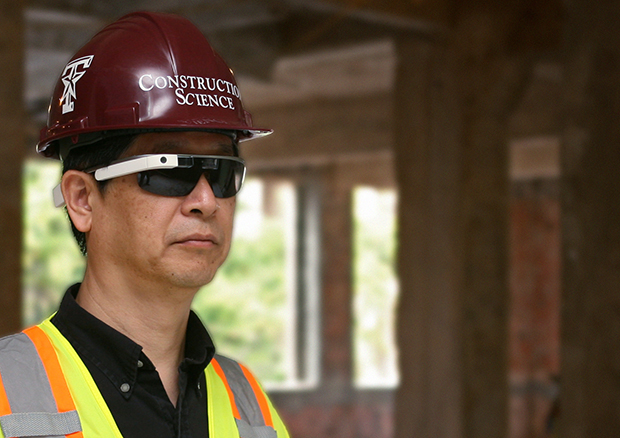CoSci professor testing Google Glass for construction projects
Julian Kang is developing research projects to determine Google Glass’ applicability for construction and facility management.
In the near future, supervisors at construction sites might perform their duties with help from a wearable computer, said Julian Kang, associate professor of [construction science] (http://cosc.arch.tamu.edu/) at Texas A&M.
Kang is one of only a few thousand people chosen by Google to use and test its latest device, [Google Glass] (http://www.google.com/glass/start/) , a mobile computer that resembles a pair of glasses and includes a small display by the wearer’s right eye and a camera that records and uploads video and still images. The device is not yet available to the general public.
Kang is developing research projects using the device to test its applicability for construction and facility management.
For instance, he said, a supervisor could create, hands free, a still image or video of a safety hazard on the jobsite, upload it immediately to a central server, and describe the hazard. The image files could immediately be uploaded to a central server, and a user could annotate the image files with speech, which Google Glass can convert into a text file.
“Without a device like this a manager might see a hazard and decide to document it after returning to the site trailer,” said Kang. “But one might get distracted, and the next day someone could get injured,” said Kang.
Or, he said, a user could use Google Glass to scan a barcode on a jobsite component and gain instant access to detailed information on the material in question.
Construction supervisors needing direction from an architect about an element at the jobsite, said Kang, could also use the device to photograph the element and communicate with the project’s architect on how to proceed.
People in multiple locations, he added, could deliberate issues like these, across the globe in real time.
Construction managers could also patrol a jobsite while reciting a punchlist and making sure everything is being built according to specifications, he said. Google Glass could convert the spoken list into a text file and upload the list to a central server, which could immediately be shared with all the project’s subcontractors.
Using wearable computers is something that has been talked about in the industry for almost a decade, he said.
“There were other devices that have been introduced, but all of them had some limitations,” he said. “Some of them were too bulky or couldn’t be controlled by voice commands. None of the devices that have been discussed are as practical as Google Glass, which changes the way we communicate with computers and presents interesting possibilities in construction and facility management that I will investigate.”
Kang isn’t the only faculty member at Texas A&M intrigued by the possibilities of Google Glass.
Sherman Finch, assistant professor of visualization, is using the device to investigate using sound for creative visualizations and in [sonification] (http://www.earthzine.org/2013/07/23/sonification-data-like-youve-never-heard-before/) - representing data in an audio format.
“Wearable technologies present the promise of incredible future applications,” he said.
Tags
Related Posts

13 outstanding alums share how college aided their success

Pixar Viz alumnus enlightens students with technical skills

Survey: Undersized IT budgets stifling building industry
Follow Us
Facebook Twitter Vimeo Youtube Flickr RSS
Recent Posts

Planning prof heads study of disaster housing aid

A message from the dean

Former student remembered as expert planner

Leading educator named new head of Architecture Dept.






_thumbnail_small.png)
